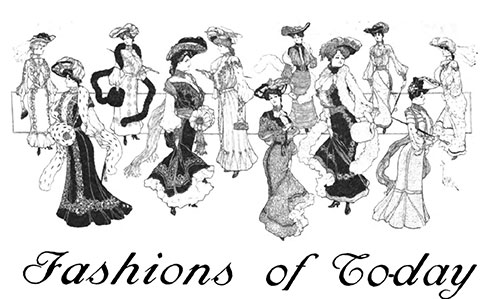Today’s Fashions – November 1903

Sloping shoulders—in fact, the elimination of all shoulder lines—is a distinctive feature of the newest modes, and this is accomplished not only through the shaping of the garment but by the disposition of the trimming as well.
Coats and bodices both carry out this idea, which is particularly becoming to the tall, slender figure. All the present modes require supple, pliable materials, and the gauging of skirts at the girdle, a noticeable feature even in walking frocks, demands the use of thin fabrics.
Without weight is the order in the feminine costume; the new wools of all grades in fine texture, however shaggy the surface, show the appreciation of this fact.
Accentuating the drooping shoulder effect is the deep, pointed bertha characterizing a new bodice for which silk voile was used. A pretty effect results from the shirrings that form a girdle. If intended for evening wear, the neck may be made low and the sleeves in elbow style.
A skirt to accompany this bodice is made full with five deep tucks in the lower part and two clusters of shirring above. The graceful simplicity of this style will appeal to tall, slender women.
The subject of coats is an interesting one, and the variety of styles is sufficiently great to enable everyone to find something individually becoming. Close-fitting coats will occupy a conspicuous place among the Winter modes, and many of these are severely tailored with more seams than of old, as a concession to the straight front figure.
To have this coat a success it must be fashioned by a first-class tailor or modiste. It will be seen in all lengths, that reaching the knee being particularly in evidence, and the wise woman will have her coat in the length best suited to her figure.
No short woman should wear a coat that is longer than the half way line of the skirt, unless it reaches to the bottom of her gown.
There are many attractive new designs for loose coats for afternoon wear. The materials used for these garments are the lustrous-faced cloths, silky zibelines and velvets, and in many instances, they are elaborately trimmed. The long shoulder line is achieved by the addition of one or two capes.
All skirts, save those for dress occasions, are being made shorter and are taking on a round line, and although long, trailing skirts are still the favorites for evening wear, many frocks intended for elaborate functions are made without a train, being cut round and merely clearing the floor.
When heavy materials are employed, the skirt in almost every instance retains rather close-fitting lines at the top, with a decided flare at the bottom. Strappings, braid, etc., will be extensively used for decoration.
An association of contrasting fabrics is suggested in a seven-gored skirt that has a fan plaiting let in the lower part of each side and back seam, Buttoned-on straps add an ornamental touch.
Less severe than the tailored coat-and-skirt costume is the new shirt-waist suit of velvet or of soft fancy wool material, made with the shirt-waist having the Louis XV skirt in short three-quarter or long hip length—a garment that so closely resembles a coat as to be substituted for one when the weather is mild.
Self or contrasting strappings and large buttons lend ornamentation to this modish gown, than which there is none more serviceable.
In the past few seasons the all-the-year-round tub shirt waists have gained many advocates, and the fashion, being a practical one, will not easily lose its prestige. The washable shirt-waist for general Autumn and Winter wear should not be the dainty, sheer garment worn in midsummer.
Mercerized goods, cheviots, vestings, etc., are admirably adopted to the purpose, and white is perhaps the favorite, though there are attractive samples in dark colors. These shirt waists should be rather severely shaped, and if trimming be desired, it is achieved through a tasteful disposition of buttons.
Box-plaits distinguish many of the smartest designs, and frequently strappings are added, while a removable chemisette will lend a pleasing air, especially when fashioned of a contrasting material. Another interesting feature in some of these garments is the “1830” sleeve with gauntlet cuff.
The hip yoke is far too becoming to be banished, and many of the smartest skirts are characterized by this feature, which, by the way, may be carried out in numerous ways.
A new four-gored walking skirt may be made with the hip yoke. The skirt is tucked in inverted box-plaited style to graduated flounce depth. A row of buttons down each seam add a pretty touch, especially when the skirt is made of dark-blue cloth and the buttons are gilt.
“Fashions of To-day” in The Delineator: An Illustrated Magazine of Literature and Fashion, Paris-London-New York-Toronto: The Butterick Publishing Co., Ltd., Vol. LXII, No. 5, November 1903 p. 683.
Editor's Note: Some terminology used in the description of women's clothing during the 1800s and early 1900s has been changed to reflect more modern terms. For example, a women's "Toilette" -- a form of costume or outfit has an entirely different common meaning in the 21st century. Typical terms applied to "toilette" include outfit, ensemble, or costume, depending on context.

